Writing historical fiction? All the Light We Cannot See by Anthony Doerr can teach you a lot. We reverse-outlined this Pulitzer Prize winner in Plottr and found simple, powerful lessons for telling stories that move readers.
Who is Anthony Doerr?
Anthony Doerr is an American author who was born and raised in Cleveland, Ohio. He’s the author of the novels About Grace, All the Light We Cannot See, and Cloud Cuckoo Land, plus memoir and short stories that have won five O. Henry Awards!
You can read the authors’ full bio on his website.
Key Takeaways: Why Study All the Light We Cannot See?
We used Plottr to break down the book step by step. That helped us spot these key tips for planning and writing great historical fiction:
- Great prologues and openings make us invest
- Alternating viewpoints with high stakes adds suspense.
- Check POV distribution to weave in key voices.
- Keep a character dossier to avoid getting lost.
- Use time shifts to sustain suspense.
- For depth, show the humanity in us and them.
Download a Plottr summary of the book here.
Then, explore each of the lessons in writing historical fiction, with examples from Doerr’s war novel.
What’s a Brief Summary of All the Light We Cannot See?
All the Light We Cannot See follows Marie-Laure LeBlanc, a blind French girl, and Werner Pfennig, a German orphan and radio expert. Their lives collide in Nazi-occupied Saint-Malo, France, during World War II.
As the war rages on, both face danger and hard choices, yet their stories show that even in uncertain and oppressive times, there’s still hope and light.
How is This War Novel Structured?
Doerr splits the novel into 14 sections, numbered starting from ‘zero’. Remember to download the Plottr summary above for a detailed breakdown. If you don’t already have Plottr, try it free for 30 days:
Zero: August 1944
Eight short, prologue-like chapters start the story in medias res, just before the French city of Saint-Malo is bombed.
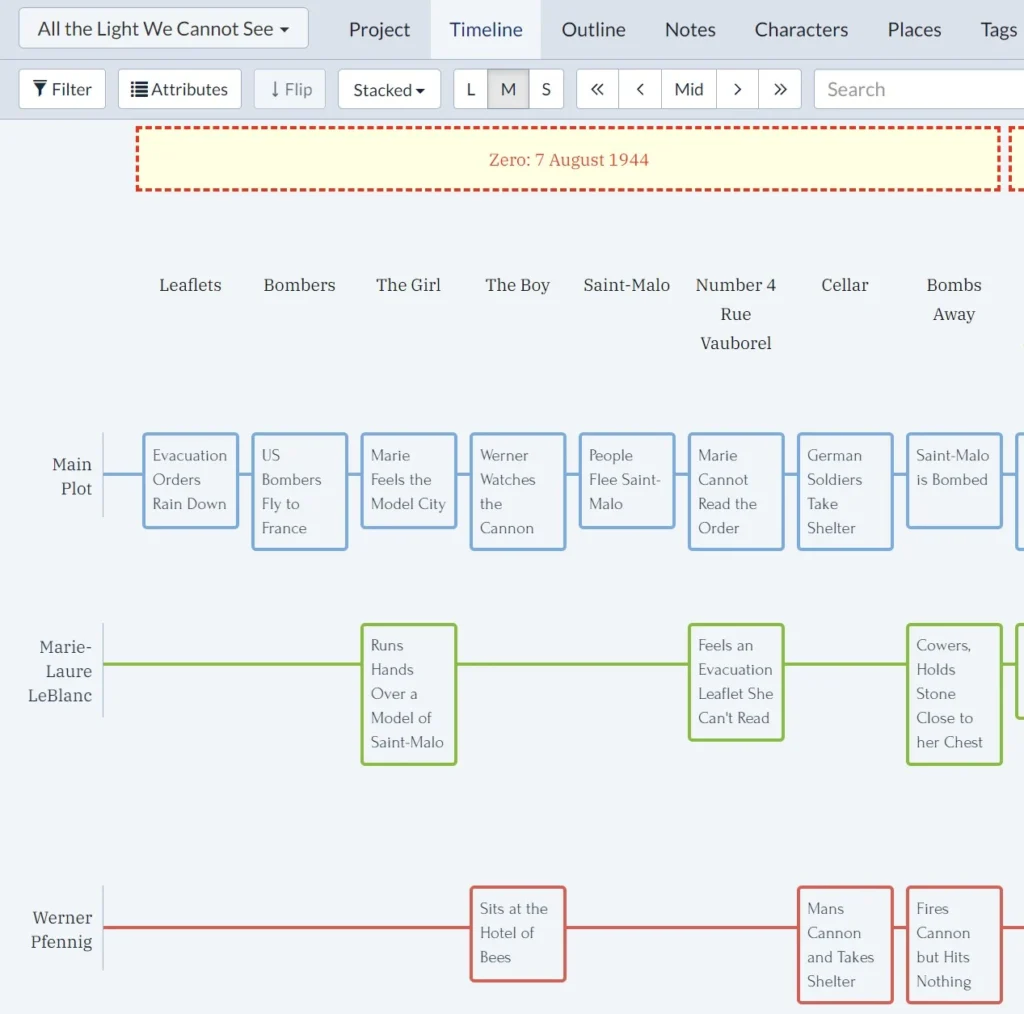
One: 1934
We go back ten years to when Marie and Werner were kids. This part has 24 short chapters.
In Paris, six-year-old Marie-Laure loses her sight. Her father, Daniel, helps her adjust to the world.
In Germany, Werner lives in an orphanage with his sister, Jutta. He finds an old radio and fixes it, sparking a love for science. He also shows Jutta the coal mines where their father died.
The section ends with Marie-Laure and her father fleeing Paris as the Nazis close in. Meanwhile, Werner catches the eye of Nazi leaders after fixing a soldier’s radio.
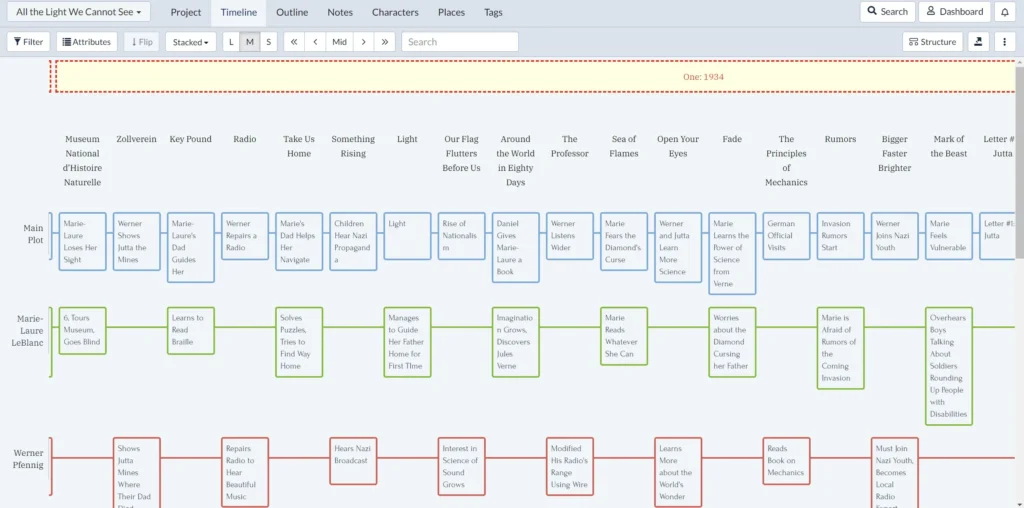
Two: 8 August 1944
We jump forward ten years again. This section is short—just five chapters.
Saint-Malo has been bombed. Marie-Laure hides in her great-uncle Etienne’s house and wonders if he’s still alive.
At the same time, Werner is trapped under the ruins of the Hotel of Bees in the same city.

Three: June 1940
We go back in time again. Marie-Laure and her father flee Nazi-occupied Paris and head to Saint-Malo. They stay with her great-uncle Etienne. This section is longer, with 27 short chapters.
In Germany, Werner is sent to an elite Nazi school. The harsh training and lessons test his morals.
Meanwhile, a Viennese sergeant major named von Rumpel is hunting a rare diamond: the Sea of Flames. The museum gave it to Marie-Laure’s father, Daniel, for safekeeping.
One day, Daniel is called back to Paris. On the way, he is arrested.
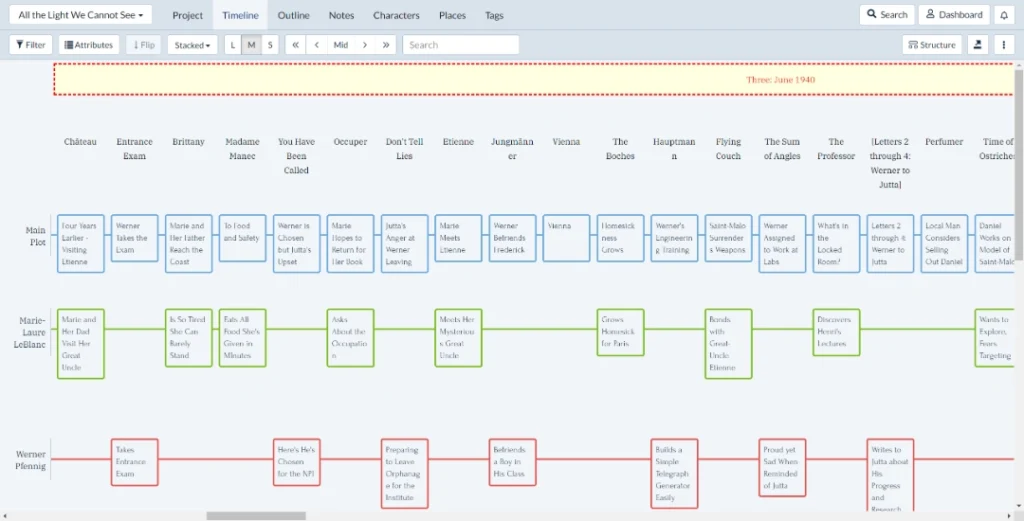
Four: 8 August 1944
We jump forward four years again, back to where the novel began. This is a short section with six chapters.
Marie-Laure is hiding in the cellar of her great-uncle’s house.
Across the city, Werner and his fellow soldiers are trapped under the Hotel of Bees. They’re running out of time and hope.
The section ends with the doorbell ringing at Etienne’s house and footsteps below. It’s a tense moment that leads to the next time shift.
Five: January 1941
We jump back three years to 1941. This section spans 33 short chapters.
At the Nazi institute, Werner sees cruelty all around him. He tries to support his kind friend Frederick (but only in secret).
In Saint-Malo, Marie-Laure misses her father and wonders when he’ll return.
Von Rumpel finds out there’s a fake diamond meant to fool anyone looking for the real Sea of Flames.
Meanwhile, the French resistance grows. Marie-Laure’s great-uncle Etienne begins sending secret radio messages, hidden in loaves of bread from a local bakery.
Marie gets a letter from her father in prison. He hides the truth to keep her hopeful.
Then, Madame Manec, Etienne’s brave housekeeper, dies.
Six: 8 August 1944
We flash forward to 1944 again, in a short five-chapter section.
Marie-Laure is alone in Etienne’s house. She hears an intruder (Von Rumpel) and fears he’s after the diamond. Etienne has been captured and taken to the Fort National.
Werner is still trapped under the Hotel of Bees. His friend Bernd dies, and Werner works to fix a radio. Marie-Laure prepares to defend herself.
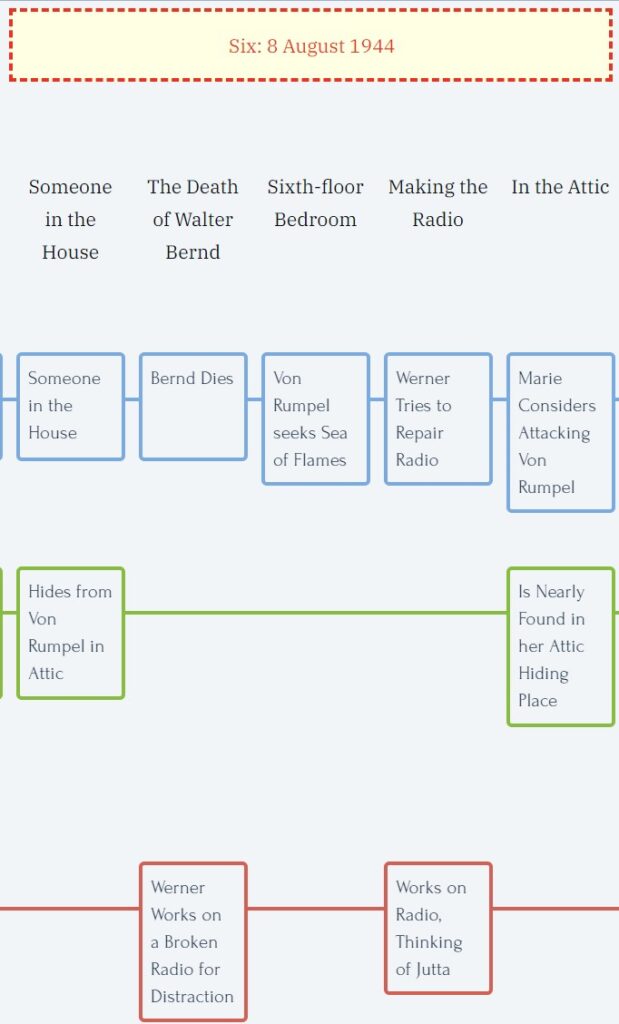
Seven: August 1942
We flash back two years earlier, in a longer section of 20 chapters.
Werner, now on the Russian front, sees prisoners treated with shocking cruelty. In France, Marie-Laure and Etienne keep sending secret radio messages from the attic.
Von Rumpel follows more clues that lead him closer to Marie and her father. A new officer in Saint-Malo starts to suspect their broadcasts.
Eight: 9 August 1944
We skip ahead two years, back to Marie and Werner’s tense timeline. The French are trapped as Allied bombs fall.
Marie-Laure hides in the attic, reading from 20,000 Leagues Under the Sea over the radio. Werner hears her voice and the music. He remembers it from the radio he fixed as a boy.
The science talks he once loved were recorded by Marie’s grandfather, Henri.
Nine: May 1944
We jump back a few months to a longer section of 20 short chapters.
Werner and his unit are sent to Saint-Malo to track down the source of a secret radio broadcast (Marie and her great-uncle’s).
A Nazi informant, Claude Levitte, betrays Marie by tipping off Von Rumpel, who corners her in a sea grotto. She escapes, and Etienne agrees to take over the broadcasts to keep her safe.
The section ends with Werner hiding the truth about Marie’s broadcasts, and with Etienne’s arrest.
Ten: 12 August 1944
We jump forward again to August 1944, in a longer section of 18 short chapters.
Werner hears Marie on the radio say the intruder will kill her. He admits to Volkheimer that he found her broadcast weeks before and kept it secret.
Marie plays music loud through the house (and over her broadcast), hiding behind a panel in Etienne’s attic. The music gives Werner and Volkheimer hope. They use rubble to shield themselves and blast their way out of the hotel.
Werner hurries to Etienne’s house, kills Von Rumpel, and helps Marie out of hiding. They share a can of peaches and rest.
Werner leads Marie to safety and reunites her with the bakery woman and her uncle, now freed. The section ends with Werner’s capture and death by landmine.
Eleven: 1945
A year later. This is a short section of two chapters, one set in Berlin, and the next in Paris. In Berlin, Werner’s surviving sister Jutta suffers under Russian occupation. She is sent to work in a factory where soldiers assault the women and children.
Marie-Laure and Etienne, meanwhile, have moved to Paris where Marie hopes to resume school.
Twelve: 1974
Volkheimer receives details about Werner’s death and visits his sister, Jutta. Marie learns from a private investigator that her father died of flu in a labor camp in 1943.
Volkheimer gives Jutta a model house that once belonged to Marie. Jutta visits Marie in Paris and returns the model. Inside, Marie finds the iron key to the Saint-Malo grotto — the one she gave Werner long ago.
The section ends with Jutta mailing a letter to Frederick, Werner’s old friend. She includes a letter from Werner, but Frederick doesn’t seem to care.
Thirteen: 2014
The last chapter is untitled and follows Marie-Laure in the present day.
Now an old woman, she walks through Paris with her grandson. As they part, she listens to his footsteps fade and thinks of all the loved ones she’s lost — Etienne, Madame Manec, Werner, and her father — wondering if their spirits still walk the streets too.
What Historical Fiction Writing Lessons Does This War Novel Share?
Let’s go back to the big lessons we spotted at the start.
This story of unlikely friendship and survival in dark times shows just how powerful good historical storytelling can be.
Here’s why it works so well:
Great Prologues and Openings Make Us Invest
Ever want to skip a prologue because you think it’s just going to be a dull infodump? You’re not alone.
In All the Light We Cannot See, Doerr does something different. The Zero section of eight short fragments (some less than a page long) is full of tension:
- Nailbiting historical events: Evacuation orders that a young girl cannot read; stealth bombers crossing the English channel
- We feel for the people caught in chaos Marie hiding alone in an unfamiliar house, Werner trapped in darkness under the rubble, unsure if he’ll ever get out. Their fear and courage pull us right into their stories
These opening pages don’t info-dump. Instead, they share just enough of the following:
- Historical context: Doerr lets us know vital context, such as the year, place, and stage of World War II at this moment
- Character-focused action: Marie-Laure and Werner’s stories zoom in on personal moments during a global conflict—fleeing, hiding, waiting, hoping. These intimate glimpses add heart and humanity to sweeping historical events, making the past feel close and alive.
Alternating Viewpoints with High Stakes Adds Suspense
Reverse outlining a historical epic like All the Light We Cannot See shows how multiple viewpoints work together.
By laying out scene cards, you can see how Doerr carefully alternates between Marie-Laure’s and Werner’s arcs. Each time he shifts perspectives, he builds suspense: pausing one storyline at a cliffhanger as the other unfolds.
Layer in strategic time shifts, and you’ve got a narrative rhythm that keeps readers hooked, always reaching forward for answers.
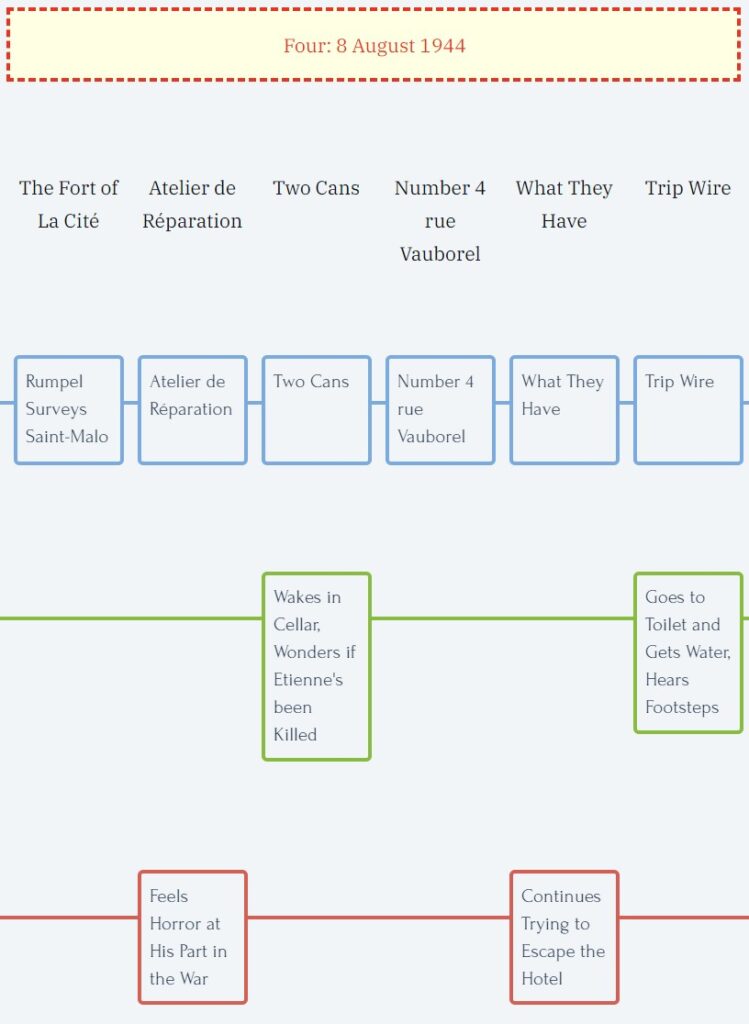
Check POV Distribution to Weave in Key Voices
In outlining historical fiction, several Plottr features are useful.
For example, you can use the ‘Small’ view (click ‘S’ in the Timeline view) to see each scene card represented as a dot in a grid.
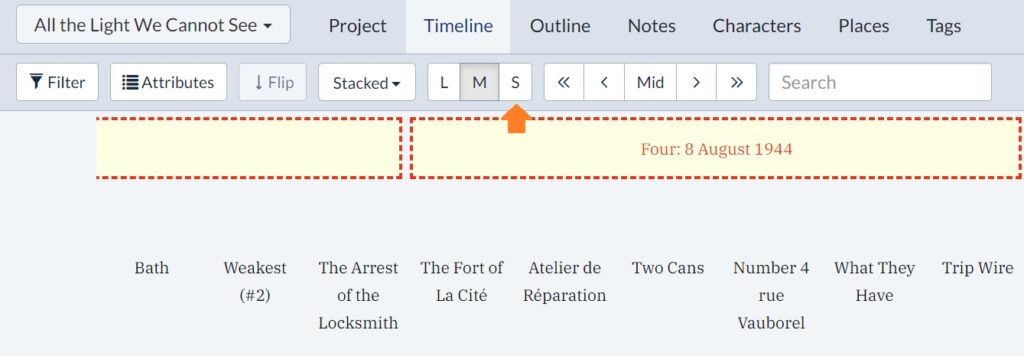
When you organize plotlines by character, it’s easy to spot how your viewpoint chapters are spread across the story.
You can track pacing, spotlight imbalances, and make sure each arc unfolds with purpose (without letting one narrator overshadow the rest).
POV Distribution in All the Light We Cannot See
Looking at this for All the Light We Cannot See, we see Jutta’s plotline comes and goes, without her having much focus.
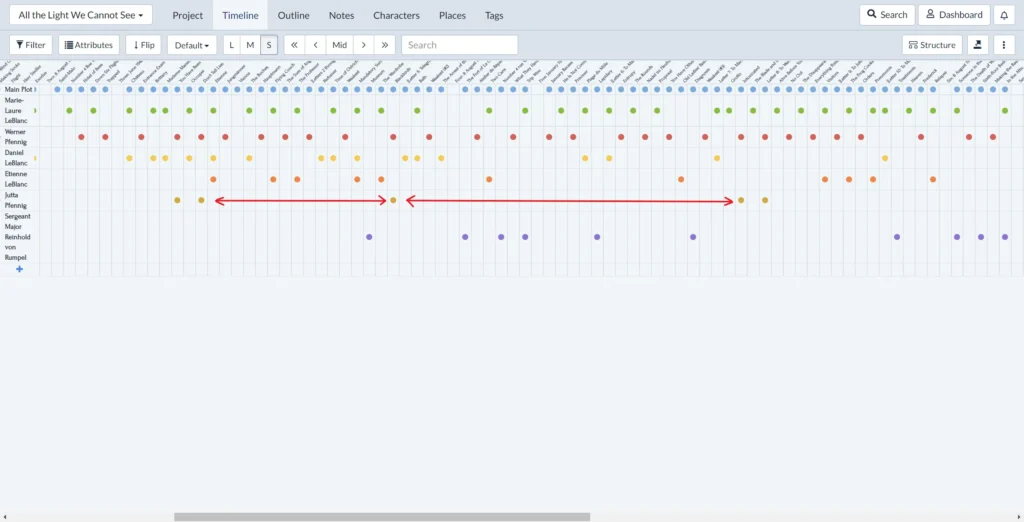
This throws into relief some truths about Jutta’s role in the story:
- She mainly serves as a tie back to conscience: Jutta sees through the Nazi propaganda, and reminds Werner of his childhood, lost innocence and humanity at key points
- A bringer of closure: Jutta returns the model city to Marie-Laure towards the end of the story, and also sends Werner’s letter to Frederick
The way Doerr brings Jutta back at the end of the book, as a survivor, gives satisfying resolution to her otherwise sparse arc.
Keep a Character Dossier to Avoid Getting Lost
Looking at the wide cast in Doerr’s novel is a great reminder: organizing your story from the start is essential: especially in historical fiction.
You’ve got main and side characters, family across generations, soldiers, resistors, and collaborators, all spread across countries and timelines.
With Plottr, you can keep it all straight: build and filter character summaries with avatars, and pin characters to scene cards so you always know who shows up when (and where) in history.
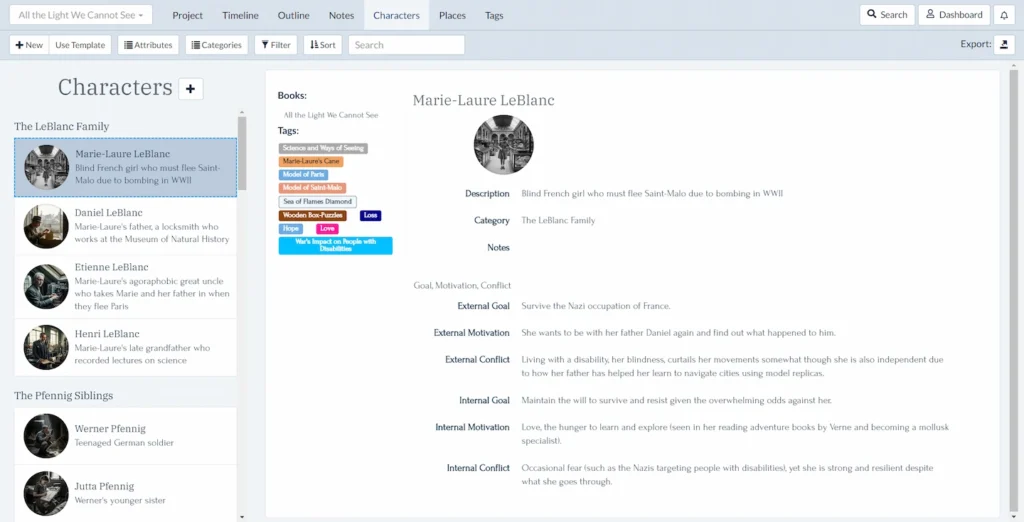
You can also use Plottr’s built in character templates to flesh out characters in depth. In the demo linked above, we used:
Use Time Shifts to Sustain Suspense
Another thing reverse outlining All the Light We Cannot See underscores is how well Doerr uses time cuts to create miniature cliffhangers.
For example, there are these section-ending moments:
- Zero: 7 August 1944 – Bombs fall and the lights go out
- One: 1934 – Marie-Laure’s father wonders whether he’s carrying the real Sea of Flames diamond or a counterfeit
- Two: 8 August 1944 – Werner mouths that there is no way out after bombing causes the Hotel of Bees to cave in
This pattern continues, with sometimes cuts like the above of ten years between a suspended narrative and its continuation creating long waits to find out how a character made it out alive.
Although the book is a literary war novel, it often reads like a thriller due to the suspenseful way it creates anticipation.
For Depth, Show the Humanity in Us and Them
In a world that often feels divided, All the Light We Cannot See reminds us that “us” and “them” are rarely so different; and that compassion, not cruelty, is what helps us break the cycle of conflict.
The novel doesn’t reduce its characters to simple labels. Instead, it shows how backstory, history, and hard choices shape each person’s path. Writing with that kind of depth takes heart … and a whole lot of planning!
That’s where Plottr comes in: a place to track your research, organize historical details, and keep the human story front and center.
Plan and Write Epic Historical Fiction
Ready to outline an awe-inspiring slice of history? Start now with a free 30-day Plottr trial.
What book or movie would you like a breakdown of in Plottr? Comment below!

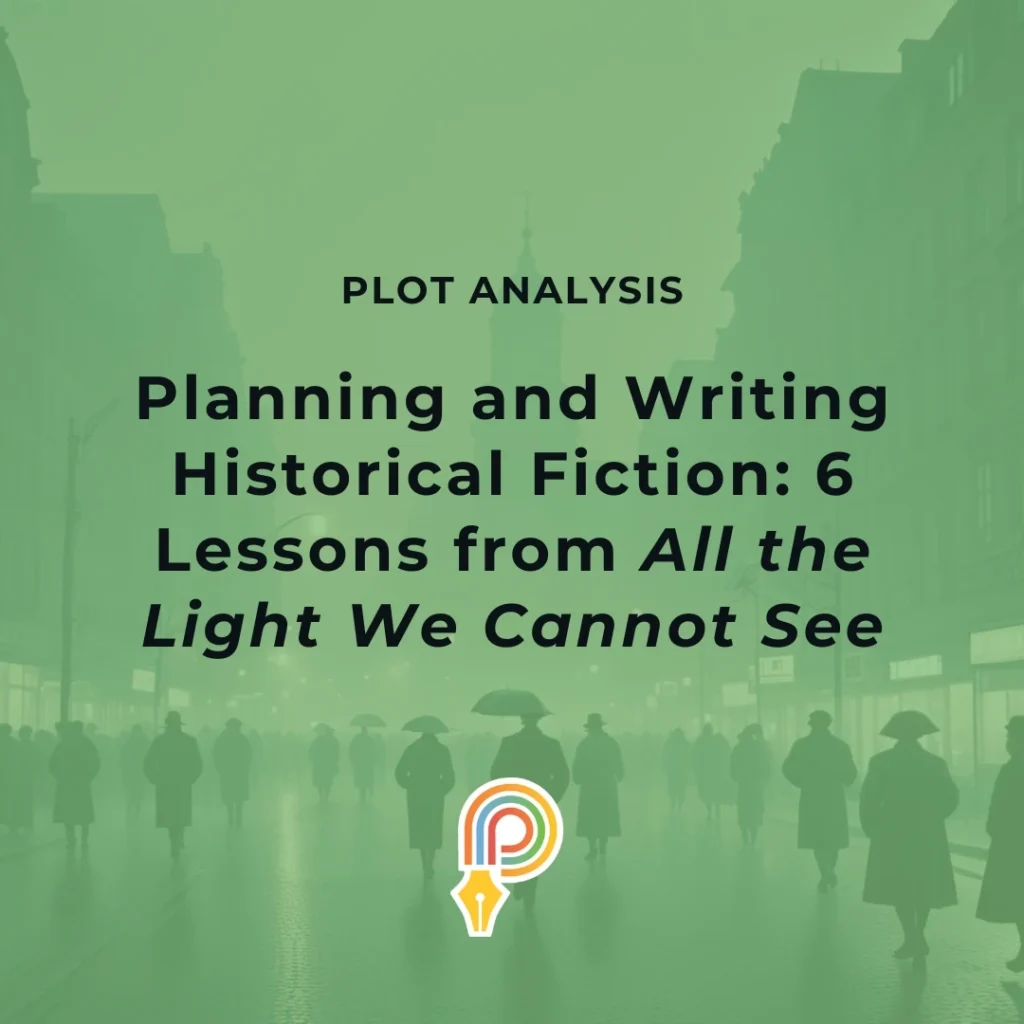





2 thoughts on “Planning and Writing Historical Fiction: 6 Lessons from All the Light We Cannot See”
This tool looks like a game-changer! I appreciate the tailored advice for historical writers, can’t wait to try it out.
Hi Eileen, thanks for reading and sharing your feedback! Please do, we have a free 30-day trial. Let us know how you get on.